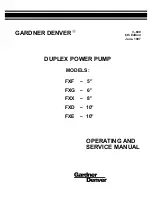
The discharge piping should be sized to properly handle the maximum flow and
pressure developed by the pump.
When the pump operates with a suction lift, the suction pipe should slope upward to
the pump from the source of supply (Figure 3.4, Suction Lift Piping). Provision must be
made for priming the pump. To maintain pump prime, a foot valve can be used with
an opening at least as large as the inlet piping. An alternate method would be to use
a shutoff valve on the discharge line and a vacuum pump to draw air out of the pump
and suction line.
Figure 3.4
Suction Lift Piping
When pumping liquid from a tank, the suction line must be submerged enough so air
is not drawn into the suction line from a vortex. Increasing the size of the inlet pipe to
reduce the velocity will help to prevent the vortex from forming.
Hot liquids within the temperature range of the pump must have sufficient positive
head to prevent vaporization at the impeller inlet. Consult the factory for NPSH
requirements of the pump for your application.
The pump must never be throttled on the suction side.
After installation, test the suction line with water at 30 psig (2.1 barg) pressure to
detect leaks.
3.8
Bypass Piping for Multi-Stage Pumps
Sufficient flow must be maintained through a multi-stage pump so the pump does not
overheat. Low flow rates result in excessive energy accumulation and heat build-up
in the pump. Minimum recommended flows are shown in Section 2.0 (Tonkaflo
Specifications).
10















































